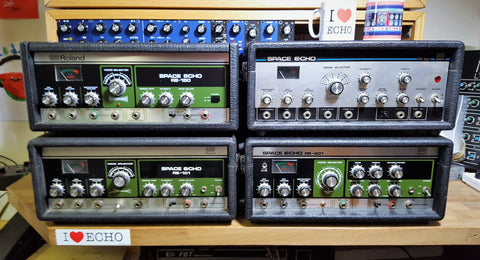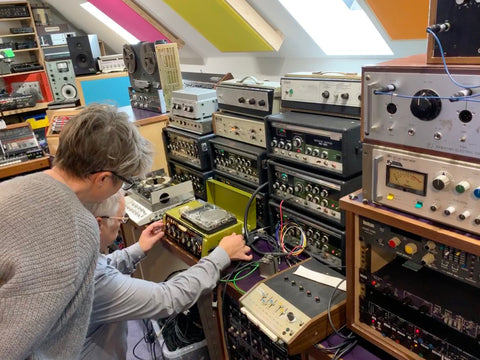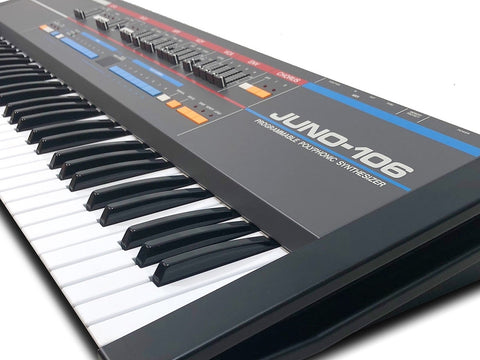Buying a Binson Echorec - Modern Pedal or Vintage Machine? by Tony Miln
Mar 14 2018 6 Comments Tags: Binson Echorec, Echosex, Gear History, Guitar Pedal, Gurus Amps, Tape / Disc Echo, valve/tube tech
Why buy an original Binson Echorec?
Original Binson Echorecs are the classic Ferrari of electro-mechanical delays. They’re rare, expensive, require specialist restoration and servicing, parts are scarce, and they need to be cared for and run regularly to remain in top condition.

Once the preserve of the lucky few - in 1962 a Baby Binson cost around £140 (£20 less than a Fender Stratocaster, £20 more than a Vox AC-30) and most of those British guitarists wishing to replicate the sound of Hank Marvin and the Shadows, Syd Barrett and Pink Floyd (and latterly David Gilmour) had to make do with a Watkins Copicat (the Mini of echoes?) rather than such costly Italian exotica.
Today, guitarists, keyboard players and electronic musicians have a choice of comparatively inexpensive options for recreating the Binson sound that would make them the envy of sixties musicians.

What pedals recreate the Binson sound?
The guitar pedal market is saturated with overdrives, fuzzes and a myriad versions of classic circuits, but perhaps unsurprisingly, there are only a few pedals that can approximate the sound of a Binson.
From the USA, Catalinbread were the first into the fray - by quite some margin - with their Echorec. Next came Gurus with a pedal that could only have come from Italy - the Echosex 2º - which, though only offering single head repeats, got very close to the sound of a valve Binson. Hot on their heels were Dawner Prince Electronics with the uniquely-monikered Boonar (nope, me neither) which crammed full Echorec 2 functionality into its diminutive form factor. Gurus followed the original Echosex with the Echosex 2º Ltd which sported a fancy gold paint job, was optimised for guitar, and limited to only 500 units. Foxpedal’s versatile delay, The Wave, features a single head Binson emulation alongside Echoplex EP-3 and Roland RE-201 options. Gurus have recently released the Echosex 2º T7E which shares the multihead functionality with its namesake Binson Echorec 2 T7E and Dawner Prince are rumoured to be working on a valve version of the Boonar.
Which is the best Binson pedal?
Undoubtedly, there are many answers to this question: potential buyers have many different requirements/tastes and each pedal has advantages and disadvantages with the result that no single pedal thus far released can be said to be the outright winner. I intend to cover this question in more detail in a forthcoming blog.

What about a modern Binson?
Those who yearn for a true electro-mechanical modern Echorec, have for some years been well-served by Marcello Patruno’s Special Binsons. These superb machines are the ultimate modern interpretation of Dr Bonfiglio Bini’s original Echorec. Signore Patruno has steadily improved the design and engineering to a point where it’s quite fair to suggest that his valve machines are what Binson would be building today if they were still in business. The technical performance could be said to be almost too good - the lack of noise and modulation on the repeats takes some acclimatising to for those raised on vintage Echorecs - but they represent the pinnacle of Echorec engineering. As you would expect, this level of quality does not come cheap and, like the original Binsons of the 60s, the valve machines are the sole preserve of the well-heeled musician. They perform so flawlessly that those seeking to replicate the warm modulated repeats of Marvin, Barrett, Gilmour, Waters and Wright, may find them a touch too clean. Indeed, it is precisely those flaws and foibles that make a vintage Binson so special, though I think it fair to say that the valve Special Binsons deserve their place at the top table as one of the most technically-advanced electro-mechanical echoes ever produced.
Then there's Phil Taylor at Effectrode: he's been working on his Echorec 3 for some years - that's one I would love to see come to fruition. His latest news on the subject is here:
http://www.effectrode.com/echorec-3/

Denmark’s T-Rex Effects set everyone’s hearts racing with their teaser at 2017’s NAMM showing a mock-up of the new compact Binson Echorec that they are developing. Read more about this on my previous blog post here. This is undoubtedly an exciting prospect as T-Rex have an unerring eye for detail and high quality engineering. Their Replicator is a personal favourite - it’s never going to challenge a well-maintained vintage quarter inch tape echo for echo fidelity, but as a colourful and creative tone machine, it’s a winner. I anticipate the joys of a T-Rex Binson, but I would expect it to be (as with the Replicator) an addition to the armoury rather than a direct replacement for a vintage Echorec.
Stop Press! Just found their latest update - they're working on how to make the heads stable so they can be adjusted for factory calibration yet not move once shipped/gigged. That's a tough gig, but they'll figure it out for sure. This is a very exciting project.

So, given the choices outlined above, why would I recommend that someone buy an original vintage Binson Echorec?
Firstly, there’s the sound. A well-restored valve Echorec, especially with added varispeed control, is sonically peerless. I’ve heard many Binsons and all of the available above-mentioned alternatives, and I’d take an imperfect well-used original over them all, as long as it’d been well-serviced and came from a reliable source.
My first Binson is still in our studio - it’s very worn and for many years only made strange noises, the like of which I’ve never heard before or since - but I’ve kept it all these years because of its character. The Baby Binson I chose to keep is not the best example I’ve had, but it has a sweetness and sound that I couldn’t bear to part with: I recorded most instrumental parts of an entire album through that preamp.
My Echorec 2 is one of the best half dozen Echorec 2s I’ve heard in over twenty years and, together with the Baby, is one of a handful of pieces I’d grab if our studio was on fire (God forbid).
For some people, it’s simply a case of authenticity - we prefer vintage guitars to new ones - and there’s no denying the presence a fine Echorec exudes in a studio with the backlit plexiglass panel and glowing magic eye level indicator.
That authenticity of course goes well beyond the physical: as I mentioned above, for those of us more inclined to abusing our Binsons, there really is nothing else that sounds like a valve Echorec’s self oscillation. And nothing can come close to the joyful noise you make overdriving the inputs of any Binson - valve or solid state - and cranking up the feedback.
Then there’s the preamps: a guitar just sounds so good through a valve Binson - real valves running hot at full voltage (rather than backlit with a green led for effect!). The valve preamp in a Binson is a thing of great joy as Dan and Mick found when we lent them one of our restored 603s for their Echorec edition of ‘That Pedal Show’.
Then there’s the engineering, and the joy of using a piece of equipment built with love and care in an era when quality was of paramount importance (this doesn’t necessarily apply to all Binsons of the seventies!) - before bean-counters predominated designers. Marvel at the delicate pressure of the jockey wheel on the drum, the heads set perfectly to barely touch the drum, the beauty of the backlit front face.
For me it’s combination of all of the above factors, but also because I’m in the midst of a lifelong love for and appreciation of Binson Echorecs, and nothing but the real thing will float my boat. Going back to the car analogy at the start of this article, I’d choose a vintage Ferrari over a modern one every time: the feel and smell of old gear is intoxicating, and while it may not always be as reliable as a modern version (though very often it turns out to be so), the joy of using the real thing is undeniable.
What should I watch out for when buying a Binson?

I've been using and buying Binsons for nearly a quarter of a century and it's probable that I've bought and heard more Echorecs than any other living person in the English-speaking world. I’ve seen and heard many explanations as to their functionality. I will focus on what to watch out for when buying a Binson, and what questions to ask of the seller, in a forthcoming blog, but for now, be very, very wary of buying a used Binson.
The most important thing to be aware of is that many Echorecs, produced after the mid-sixties and possibly into the seventies, can be extremely dangerous due to the use of wiring with insulation that degrades over time - it can result in bare wires carrying mains voltage that come into contact with the metal case! This is potentially lethal in a machine with no earthed mains cable. I’ve had my share of shocks - the most recent from an otherwise immaculate 603 that the seller had bought serviced and rewired. A visual inspection of the wiring suggested all was well, but the tech had missed a cable hidden behind the transformer whose insulation had finally dropped off by the time I received it. The seller had been using the machine for some years without incident so had no reason to suspect there was anything wrong.
See below for a similar issue found in a restored Echorec 2 - a wire carrying HT voltage with all insulation missing - invisible as the transformer is contained in a metal case. Fortunately, it was accidentally plugged into 240v (it was set up for 110v) which immediately blew the fuse - and fried the transformer which revealed this horror.

Unless the seller can prove their knowledge and offer you concrete evidence that the machine has been serviced by one of a very small number of qualified engineers, and unless you can hear the exact machine being sold - clearly hear the quality of repeats and any mechanical noise - my advice would be to avoid like the plague, unless you access to a tech with extensive knowledge of electronics, mechanics, and valve/tape theory. And always get a new machine checked over by a qualified engineer before use.
"A cheap Binson is rarely a bargain, and an expensive one with uncertain provenance can prove very costly indeed."
A couple of further points regarding ‘serviced’ Binsons: not all restored machines are equal, even though the asking price would suggest so. Nor are all techs equal (see my experience with the otherwise perfect-looking 603 above). I have seen many examples of Echorecs that appear to be advertised as serviced and working well, but when you dig down into the detail of the description, photos or demos, it becomes very clear that they are a long way from right. And those machines advertised with barely any detail? My advice is that you should consider them to be very much for spares or repair only (and remember that a full restoration is a time-consuming and expensive job).
I’ve bought machines serviced by supposed experts, by ‘ex-Binson’ techs, by otherwise experienced engineers. Barely any have performed as I would expect from a good Echorec; many have been sorely-lacking and often dangerous. From my experience of the past twenty years with Binsons, it’s become very clear that there are very few people alive today who know how a good Binson should sound, and far fewer who know how to service and restore these incredible machines to reach their potential.
6 Comments





Maybe another option: you go to town. You ask somebody if he or she knows whether there is a “shop” in the town that has completely nothing to do with the digital stuff on the happy digital internet. If that is the case one can then ask the question "I’m actually looking for a “shop” where one can buy “records” and taperecorders new or second hand, do you know such a shop?" If that is the case, one just have to follow the directions, buys for a start the album Ummagumma or how do you spell that, make a tape of the album, and then after one push on a button off you go to a saucer full of secrets!
I have a valve PE603 TU which I’m currently re-wiring. I bought to from a friend (in Australia) around 1991. All the components had been replaced (by his friend) but not all the wiring. It had been working OK however, when I looked inside , the wiring insulation was perishing so I am in the process of completely re-wiring it. In addition, the soldering and workmanship on the previous component replacement has been really messy, so I am trying to tidy it all up. I will eventually finish it, but it is a very tedious and finicky job!!!
I want a BINSON!!!
I’ve only played with Catalinread & wasn’t overly impressed? Of course I’ve never even played with a real Echorec. But I like what I’ve heard from the Dawner Prince Boonar. And if it’s good enough for Gilmour? Thoughts on the Boonar?
Nice article Tony, I just wish I could afford a Ferrari to go with my Echorec!
My restored Echorec was done by the late Eric Snowball and I have 2 other’s that I hope to get restored eventually. Is the Soundgas tech still my beat option? Expensive yes I’m well aware of that part, but like a Ferrari, it needs to be done right with no matter what the expense.
Leave a Comment